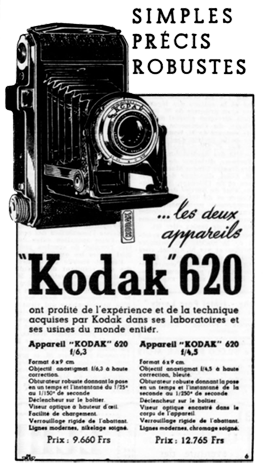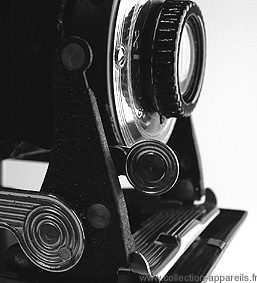|
Kodak A Modele 11 |
Manufactured or assembled in France from 1953 to (After) 1953.
Index of rarity in France: Infrequent (among non-specialized garage sales)
Inventory number: 956
See the complete technical specifications
Chronology of cameras Kodak
 At the end of World War II, Kodak had two historic factories in France: Sevran, which had been dedicated to film development since the 1920s, and Vincennes, formerly known as Pathé, and since 1927, Kodak-Pathé, where films were produced. At that time, there were no camera manufacturing units, and all Kodak cameras available in France were imported products.
At the end of World War II, Kodak had two historic factories in France: Sevran, which had been dedicated to film development since the 1920s, and Vincennes, formerly known as Pathé, and since 1927, Kodak-Pathé, where films were produced. At that time, there were no camera manufacturing units, and all Kodak cameras available in France were imported products.
As part of the reconstruction of the national industry, imports became much more difficult, and it became necessary to manufacture cameras in France that were sold there. This is what Kodak did based on four series of cameras: the 127 series whose names begin with Star, the Pony, the entry-level 135, the Retinette, the higher quality 135, and the folding cameras in the 620 format. For each of these series, Kodak used existing cameras as a base, also found in the US or UK. One may wonder whether they were actually manufactured in France or simply assembled using French-made lenses. The Brownie Flash, which is a reissue of an American model, can also be mentioned.
The folding 620 series had four successive types. They were all metal cameras, and it was only in the third version that the Ténite1 cover appeared. The opening and deployment of the bellows are automatic. The scissors are horizontal on the first three versions. On the fourth, they are diagonal, thus marking a break in the lineage of models. This is also the only version with a left-hand cover. It is interesting to compare these models to the American Tourist II, which has a right-hand cover but diagonal scissors.
The last French version is simplified, as it no longer has the closing system of the cover by pressing the plate located between the two legs that support the lens/shutter block. The end of the folding camera series is near, and Kodak no longer invests in this type of camera.
1 Ténite refers to a thermoplastic whose name was registered by Eastman in 1939. As it ages, this plastic material undergoes a chemical phenomenon that degrades it, first by forming a white powder on the surface.
| Model | Lens | Shutter | Year | ||
 folding external viewfinder |
20 | Angénieux 6,3/105 mm | 1/25 au 1/150, B |
6 x 9 | 1949-51 |
 The cover is metal. The viewfinder is part of it but protrudes |
31 | Angénieux 4,5/100 mm | Shutter release on the top synchro |
6 x 9 (carter de l'obturateur différent) |
1950-52 |
| 31 | Angénieux 4,5/100 mm | 1 to 1/250, B Shutter release on the top synchro |
6 x 9 |
1950-52 | |
| 31 Special | Angénieux 4,5/100 mm | 1 to 1/250, B Shutter release on the top synchro |
6 x 9 Protection against double exposure |
1950-52 | |
 The cover is on the right-hand side, and the struts are horizontal |
A10 | Fixfocus | B, I Non-cocking shutter Release button on shutter synchro |
6 x 9 | 1952 |
| A modèle 11 | Meniscus | B, I Non-cocking shutter Release button on shutter synchro |
6 x 9 | 1953-55 | |
| 21 | Angénieux 6,3/105 mm | 1/25 to 1/150, B Shutter release on the top |
6 x 9 | 1952-55 | |
| 32 | Angénieux 4,5/105 mm | 1 to 1/250, B synchro |
6 x 9 | 1951-53 | |
| 33 | Angénieux 4,5/100 mm |
1 to 1/250, B synchro Timer |
6 x 9 Griffe pour accessoire |
1953-55 | |
| 34 | Angénieux 4,5/100 mm | 1 to 1/250, B Synchro |
6 x 9 | 1953-56 | |
| 36 | Angénieux 4,5/100 mm | 1 to 1/250, B synchro |
6 x 9, 6 x 6, 28 x 40 mm | 1953-55 | |
| 37 | Angénieux 4,5/100 mm | 1 to 1/250, B Timer Synchro |
Periscope viewfinder 6 x 9, 6 x 6, 28 x 40 mm Griffe pour accessoire |
1954-56 | |
| 40 | Angénieux 3,5/100 mm | Prontor SV 1 to 1/250, B Timer Synchro M and X |
Periscope viewfinder 6 x 9, 6 x 6 Protection against double exposure Griffe pour accessoire |
1952-55 | |
| 42 | Angénieux 3,5/100 mm | Timer Synchro M and X |
Periscope viewfinder |
1953-57 | |
 The cover is on the left-hand side, and the struts are diagonal |
B11 | Méniscus f/10 |
Pas de marque B, I Shutter release on the top Non-cocking shutter |
6 x 9 and 6 x 6 | 1956-61 |
| B31 | Angénieux 4,5 / 100 mm | 1/25 to 1/150, B Shutter release on the top |
6 x 9 and 6 x 6 | 1956-59 | |
| B31 | Angénieux 4,5/100 mm | 1/30 to 1/250, B Shutter release on the top |
6 x 9 and 6 x 6 | 1960-61 | |
If you wanted to play the game of 7 differences between the A modèle 10 and the A modèle 11 models, it would be hard to reach 7! Apart from the obvious differences in decoration, the only real one is the distance setting on the A11.
Note the curious trigger, the wide tab of which allows a better contact with the finger. When closing the camera, the tab comes into contact with the inside of the bed. As it is fixed only by an axis, during the closure of the bed, it rotates, slightly rubbing on the bed. The arm on which it is attached has an articulation which allows it to fold when the bed is almost closed. Easy to understand by seeing the device, but really not easy to explain!


Interesting links or bibliography :
Add a link or element of bibliography, a picture taken with this camera, a picture of box or an ads about this camera
Your photos taken with the same camera:
Cameras from Ebay France (Kodak) (Uploaded each 3 hours)








